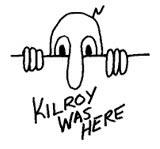Claim: The phrase "Kilroy Was Here" began as a ship inspector's mark in World War II.
Example: [Collected on the Internet, February 2008]
KILROY WAS HERE! In 1946 the American Transit Association, through its radio program, "Speak to America," sponsored a nationwide contest to find the REAL Kilroy, offering a prize of a real trolley car to the person who could prove himself to be the genuine article. Almost 40 men stepped forward to make that claim, but only James Kilroy from Halifax, Massachusetts had evidence of his identity. Kilroy was a 46-year old shipyard worker during the war. He worked as a checker at the Fore River Shipyard in Quincy. His job was to go around and check on the number of rivets completed. Riveters were on piecework and got paid by the rivet. Kilroy would count a block of rivets and put a check mark in semi-waxed lumber chalk, so the rivets wouldn't be counted twice. When Kilroy went off duty, the riveters would erase the mark. Later on, an off-shift inspector would come through and count the rivets a second time, resulting in double pay for the riveters. One day Kilroy's boss called him into his office. The foreman was upset about all the wages being paid to riveters, and asked him to investigate. It was then that he realized what had been going on. The tight spaces he had to crawl in to check the rivets didn't lend themselves to lugging around a paint can and brush, so Kilroy decided to stick with the waxy chalk. He continued to put his checkmark on each job he inspected, but added KILROY WAS HERE in king-sized letters next to the check, and eventually added the sketch of the chap with the long nose peering over the fence and that became part of the Kilroy message. Once he did that, the riveters stopped trying to wipe away his marks. Ordinarily the rivets and chalk marks would have been covered up with paint. With war on, however, ships were leaving the Quincy Yard so fast that there wasn't time to paint them. As a result, Kilroy's inspection "trademark" was seen by thousands of servicemen who boarded the troopships the yard produced. His message apparently rang a bell with the servicemen, because they picked it up and spread it all over Europe and the South Pacific. Before the war's end, "Kilroy" had been here, there, and everywhere on the long haul to Berlin and Tokyo. To the unfortunate troops outbound in those ships, however, he was a complete mystery; all they knew for sure was that some jerk named Kilroy had "been there first." As a joke, U.S. servicemen began placing the graffiti wherever they landed, claiming it was already there when they arrived. Kilroy became the U.S. And as the war went on, the legend grew. Underwater demolition teams routinely sneaked ashore on Japanese-held islands in the Pacific to map the terrain for the coming invasions by U.S. troops (and thus, presumably, were the first GI's there). On one occasion, however, they reported seeing enemy troops painting over the Kilroy logo! In 1945, an outhouse was built for the exclusive use of Roosevelt, Stalin, and Churchill at the Potsdam conference. The first person inside was Stalin, who emerged and asked his aide (in Russian), "Who is Kilroy?" .. To help prove his authenticity in 1946, James Kilroy brought along officials from the shipyard and some of the riveters. He won the trolley car, which he gave it to his nine children as a Christmas gift and set it up as a playhouse in the Kilroy front yard in Halifax, Massachusetts. |
Origins: The ubiquitous "Kilroy was here" messages found scrawled on surfaces throughout World

scribbling "Kilroy was here!" as their way of helping his frustrated bride track down her man), the strongest claim of all is the one quoted above. While the purists don't quite yet feel comfortable giving it the thumbs up, many whose standards are less stringent view the tale about a shipyard inspector as the true origin of the phrase.
The story, as set forth above, mostly adheres to the information provided in news articles from the
James J. Kilroy was a welding inspector at the Bethlehem Steel shipyard in Quincy, Massachusetts. His account, as he provided it in 1946 during a radio contest sponsored by the American Transit Association, stated that since
In a fit of pique one day, as he emerged from the hatch of a tank he'd just inspected, he scrawled in yellow crayon on its top — where testers could easily see it — "Kilroy was here." So, it is asserted, was born the phrase that would quickly travel the globe and be found in all sorts of unexpected places.
As for the graphic that has come to be associated with the phrase, it's not clear how the two came to work together. The little drawing of a man peeking over a wall, with just his eyes and nose (and sometimes his fingers) showing, began not as Kilroy but as
With GIs everywhere participating in the "Kilroy" craze during the war, "Kilroy was here" proclamations turned up all over the place, a state of affairs that provides a possible clue as to how the
phrase and the cartoon came to be wed. The endless encounters with one scrawled "Kilroy" message after another would quickly have fostered a sense of always being under the watchful eye of the mysterious Kilroy. Given that American servicemen were rubbing shoulders with a great many Brits (both civilian and military), a fair number of them would soon have been exposed to
There is one other small deviance between the
Barbara "a sated desire named streetcar" Mikkelson
Last updated: 18 February 2008
 Sources:
Sources:
